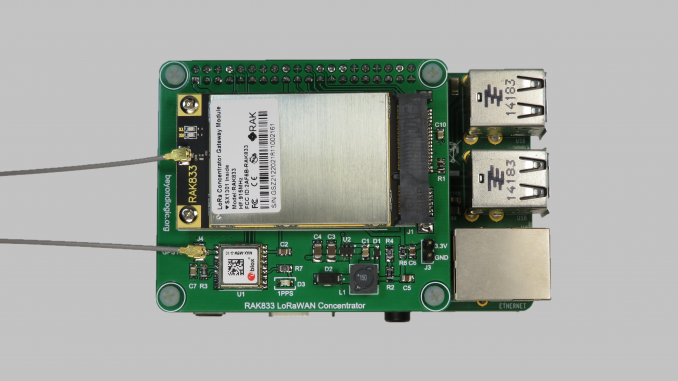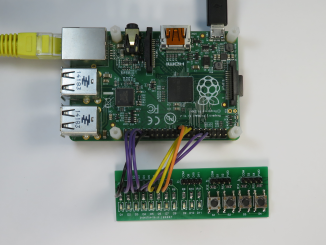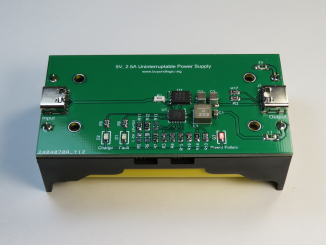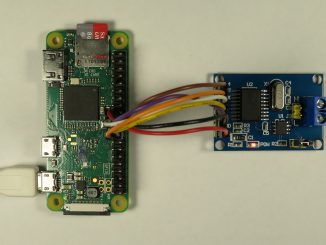
This board is a Raspberry PI Hat for the RAK833/RAK2247 LoRa Concentrator Gateway Modules. The RAK2247 is improved version of the RAK833 with better heatsinking, a boost in the maximum transmission power and improved interference immunity.
Both are a smaller version of the popular RAK831. The RAK831 is larger, about the same footprint than a Raspberry PI and requires a breakout board to convert the RAK831’s 24 pin connector to the Raspberry PI’s 40 pin connector. The RAK833 is a more elegant industry standard PCI Express Mini Card form factor (Type F2).
The RAK833 module consists of a Semtech SX1301 Digital Baseband chip for outdoor LoRaWAN Macro Gateways and two Semtech SX1257 Transceivers. The USB interface is provided by an FTDI FT2232H.
It supports both a USB and SPI interface selectable via the SPDT_SEL pin. This makes the module ideal for Raspberry PI and other Embedded Linux platforms that do no expose USB on the expansion connector.
Variants of the module are available for four different frequency ranges, 433MHz, 470MHz (China), 868MHz (Europe) & 915MHz (North America) and with or without the USB interface (FT2232H).
The RAK833-SPI/USB-xxx Mini PCie Module can be purchased from AliExpress for US$119. The non-USB version, the RAK833-SPI-xxx is US$99
Pinout
The following table provides details of the allocated I/O.
| Pin No. | PI Name | PI I/O Type | Net Name | Function |
|
8 | GPIO14/TXD0 | OUTPUT | UART_TX | GPS Receive (For configuration) |
|
10 | GPIO15/RXD0 | INPUT | UART_RX | GPS Transmit |
|
19 | GPIO10/SPI_MOSI | OUTPUT | PCIe_MOSI | SX1301 SPI Slave Input |
|
21 | GPIO09/SPI_MISO | INPUT | PCIe_MISO | SX1301 SPI Slave Output |
|
22 | GPIO25 | OUTPUT | PCIe_RESET | SX1301 Reset |
|
23 | GPIO11/SPI_SCK | OUTPUT | PCIe_SCK | SX1301 SPI Clock |
|
24 | GPIO08/SPI_CE0_N | OUTPUT | PCIe_CSN | SX1301 Chip Select |
Design Files
Design files can be downloaded from the Circuit Maker website. Circuit Maker is a free EDA tool from Altium.
- Open in Altium 365
- RAK833 version 1.A.4 Gerbers (Zip)
- RAK833 version 1.A.4 Schematics (PDF)
- RAK833 version 1.A.4 Bill of Materials (XLSX)
The PCB for this design was fabricated by JLCPCB.com. An earlier prototype was fabricated by pcbway.com.
Software – Basic Station
Instructions on how to install LoRA Basic Station can be found here.




Do you have any assembled and tested boards for sale?
Hello.
Great work!!!
Are you sharing this marvolous PCB? We are looking for a solution to make our world smart with LoRaWAN. Our goal: Spread many gateway`s in the north of Germany, caled Schleswig Holstein (sneak peek: https://riot.nordgedanken.de/iotAbdeckung/index.html).
Hope to hear from you Craig.
Best regards
Jens
Jens,
Yes, the PCB was designed in CircuitMaker and it requires designs to be made publicly available. Feel free to fork the design and modify it to suit your needs:
https://circuitmaker.com/Projects/Details/Craig-Peacock-4/RAK833-LoRaWAN-Concentrator-Hat
I have just added links on the above page to the Gerbers, Schematic and Bill of Materials for version 1.A.4. If you want to get boards make, you can submit these Gerbers to your preferred board house.
Hi Craig,
Nice work, thanks for sharing. I’m currently building one of your PiHat LoRa Gateway PCBs for use with the latest RAK2247 concentrator. I notice there’s a mis-match between the schematic and the BOM regarding R2 & R4 – the buck switch controller’s output voltage setting resistors. The BOM values seem to set an output voltage of 3.47V, whilst the schematic values are those of the Microchip reference design and set a voltage of 3.3V. Looks like you made a deliberate change here, I’d be very interested to hear your reasoning.
Thanks again.
Steve.
Steve,
I’ve just cross referenced R2/R4 values with my prototype. The schematic is correct with R2 being 31.6K and R4 10K.
I’m not sure what happened with the BOM, but these values are incorrect. Sorry for the confusion.
Craig
Thanks for your swift response and clarification. Couple of other quick questions if you’ll kindly indulge me: which GPS antenna do you use with the board? And do you have a feel for the average & peak total operating current on the 5V supply to Pi (2 or 3?), concentrator & GPS combined? I’ll let you know how I get on with the 2247.
Thanks again,
Steve.
Steve,
I have been using the Siretta MIKE3A/2.5M/SMAM/S/S/17 GPS antenna with this board.
https://www.digikey.com/product-detail/en/siretta-ltd/MIKE3A-2.5M-SMAM-S-S-17/MIKE3A-2.5M-SMAM-S-S-17-ND/6096364
I don’t really have a feel for average power consumption, sorry. I’ve been using mine on a PI 1 B+ (V1.2).
Craig
Thanks again Craig,
I’ve now just got the 2247 working, through your board, with an RPi3B+ running from RAK’s disk image. FYI it draws 800mA of 5.1V current when used with an ethernet cable and with WiFi off, during boot the current peaks at about 1A. Had a small problem with the reset pulse to the 2247 – not sure if RAK’s software is driving the right pin – so I added a small script to pulse IO25 high then low at reboot which seems to make the system more reliable over power-cycles.
I’m now considering a design for a super-cap based ups with enough energy storage to allow the Pi to shutdown cleanly prior to power-out – I’ve had quite a bit of trouble with trashed SD cards on RPis due to random power cuts.
Thanks once more for sharing your excellent work, you’ve saved me many days of effort.
Cheers, Steve.
FYI my PoE UPS Pi project is on-line at: https://www.elektormagazine.com/labs/poe-ups-pi
This makes a great complement to your board in a gateway, greatly increasing the reliability and durability of the whole system.